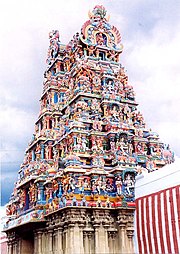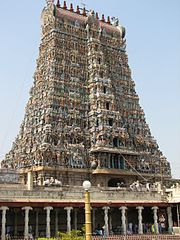The origins of the city are cloaked in myth and little of its prehistory has come to light. When Madurai steps into the limelight of history, namely through the sliver of literature of the last Sangam (Tamil poetic conclave), it emerges as a confident and sophisticated society, presupposing centuries of hitherto poorly documented development. Nevertheless the city enjoyed its reputation as a magnet for literary and artistic activity during the early centuries before and after Christ in what is called the 'Sangam Age', named after the bardic conclaves which produced a copious amount of sophisticated literature under the patronage of the Pandya kings. The early history of the city, in fact at least until the 13th century A.D., is irrevocably tied with the fortunes of the Pandya clan which ruled the far south of India with Madurai as its capital. Megasthenes, the Seleucid envoy of the Mauryan court in Pataliputra, bears witness to the greatness of Madurai in the 3rd century B.C. through his Indica, albeit surviving as a fragmentary record in the writings of other classical historians. According to the account Madurai was governed by a queen by the name of Pandeia, the daughter of Herakles. He also makes note of the kingdom's wealth and like Kautilya in the Arthasastra makes account of the rich resources much sought by traders, namely gemstones, pearls and other rare organic produce. The Pandyas and their kingdom are also noted in other early texts, for instance in several recensions of the epics (Ramayana and the Mahabharata - though these may well be later additions), in the work of the Sanskrit grammarian Katyayana, Ptolemy's Geography, the anonymous Periplus of the Erthyean Sea and perhaps more famously in the Ashokan edicts. Little note however has been made of the city's customs and physical remains though. One interesting exception however is noted by Megasthenes, namely that of individual households taking turns to supply the royal house with necessities like clarified butter and grain. This practice must have been ancient since it is confirmed by the later Tamil epic Silapadikaram. Tamil sources themselves confirm the antiquity of the city.
According to a late text, the city played host to the Third Sangam, the first two being held in coastal cities lost to the sea in distant memory. Whatever the case may be the city of Madurai has been greatly remembered in popular memory for the immense literary activity which produced some of the greatest bards and epic-writers in literary history, ranging from figures like Nakirar of Sangam fame to the late medieval child-poet Kumaragurubarar. It also hosted the literary conclaves that produced the first Tamil epics Silappathikaaram and other literary masterpieces. Underlying this literary activity was royal patronage and the Pandya kings were overly enthusiastic in the promotion of literary activity, some of them being notable poets themselves. Of course such literary and artistic activity (less attested for the early period) presupposed prosperity which the city more or less enjoyed throughout the ages with a few ruptures, the worst perhaps being the invasion of the Delhi Sultanate and the brief iconoclastic rule of the Madurai Sultans in the late 13th century. Besides literary prowess the city was also noted for its artistic activity (especially well documented after the 5th century) and its role as a religious centre both for the Brahmanic faith and Jainism. Few, if any, objects of artistic quality survive in the city from before the 5th century, at least before the rise of the Pallava king Mahendravarman who was so influential in introducing stone (more durable) as an artistic medium. Yet literature, both Tamil and classical, furnish us with some details of the industrial and fine arts of the city. Mention is made of fine lamps and exotica created for the Roman market. Sculpture of durable material (e.g. stone and bronze) could not have been entirely unknown considering the strong links with Near Eastern ports and later with Greco-Roman traders. In fact mention has been made in Tamil literature of commemorative statuary produced by Kings of the early age. Stone however seems to have been less favourable a medium due to funerary connections.

From the 5th century onwards more material, especially stone statuary, survives to validate the antiquity of the city's artistic traditions. The Meenakshi Sundareswara temple which is at the heart of Madurai does not survive in its original state for much comment to be made of its early architecture. Nevertheless the temple and its goddess, the tutelary deity of the Pandyas and according to legend an early progenitor of the line herself is surely of great antiquity. Much of its early history like the city's is shrouded in myth and little remains of 'history' to be gathered. Nevertheless it would suffice to mention that it was built originally by the early Pandya king Kulasekhara to house the Shiva Linga, apparently worshipped by the Deva Indra. The walls around the Sundarewara shrine are surely ancient since they are also attested to by the Saint Sambandar in his hymns. The artistic tradition of the city becomes clearer towards the late medieval age, especially in the Vijayanagar-Nayaka age where enough survives to distinguish numerous craft industries ranging from ivory carving to bronze-working. Turning to the religious affiliations of the city, note has already been made of the city's ancient shrine to Meenakshi and Sundareswara, in effect the divine pair Shiva-Parvati though it has been proposed that these were regional deities posthumously identified with Brahmanical deities in the complicated process of 'Aryanisation'. Nevertheless as attested by literature the Pandyas were ardent supporters of the Brahmanic faith and all temples in the city have in the foundation-myths, royal origins. The archetypal king was of course the great warrior, patron of arts and letters and above all a model of piety, perhaps surviving in sculptural form in the Nayaka king portraits in anjali mudra gracing the mandapas of Madurai's great temple. Also gracing the city in the early centuries of the first millennium were the Saiva and Vaishnava saints who produced the devotional literature represented in the Nalayira Divya Prabhandam (Vaishnava) and the Tevaram corpus (Saiva). In Madurai's history the child-saint Sambandar was probably most famous for having performed the conversion of the Pandya king who adhered to the Jaina faith. In a series of miracles the Saiva saint shamed the Jaina advisors of the King, who later suffered the terrible fate of impalement. Jainism was for most of Madurai's early history a successful rival to the Brahmanic faith. Interestingly the earliest inscriptions (2nd century B.C) in the Madurai environs belong to Jain ascetics who inscribed them on nearby granitic outcrops. Many other notable Jain sites like Sittanavasal are also to be found in the Pandya domain, most in close proximity to Madurai.
